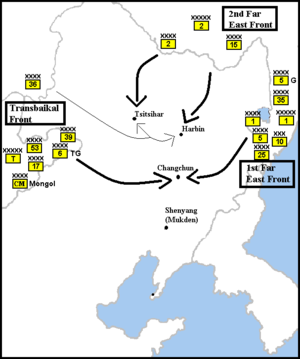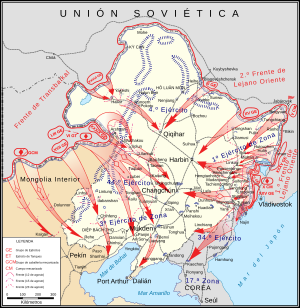الغزو السوڤيتي لمنشوريا
| ||||||||||||||||||||||||||||||||||||
| قالب:Campaignbox Soviet–Japanese War | ||||||||||||||||||||||||||||||||||||
الغزو السوڤيتي لمنشوريا أو كما أسمتها القيادة السوفيتية عملية هجوم منشوريا الإستراتيجية (بالروسية: Манчжурская стратегическая наступательная операция)، بدأت في 9 أغسطس 1945 بغزو الاتحاد السوفيتي لدولة مانشوكو العميلة لليابان في أكبر عمليات الحرب السوفيتية اليابانية، حيث تمكنت القوات السوفيتية من الاستيلاء على مانشوكو ومينتشيانغ (ومن ثم منغوليا الداخلية) وشمال كوريا وجنوب سخالين علاوة على جزر الكوريل مما عجّل باستسلام اليابان في الحرب العالمية الثانية بعد الهزيمة السريعة التي لاقاها جيش كوانتونگ بعدما وضح جليا قدرة الاتحاد السوفيتي ونيته في انتزاع كامل الأراضي اليابانية بما في ذلك التراب الوطني نفسه بعد الهجوم الخاطف على منشوريا وسخالين.[1][2][11][12][13][14][15][16]
ومنذ عام 1983 دأب إطلاق اسم عملية عاصفة أغسطس على الغزو السوفيتي لمنشوريا بعدما أورد المؤرخ العسكري الأمريكي ديڤد گلانتز هذا الاسم في أحد الأبحاث التي قام بنشرها والتي تحدثت عن العملية العسكرية نفسها.[1]
. . . . . . . . . . . . . . . . . . . . . . . . . . . . . . . . . . . . . . . . . . . . . . . . . . . . . . . . . . . . . . . . . . . . . . . . . . . . . . . . . . . . . . . . . . . . . . . . . . . . . . . . . . . . . . . . . . . . . . . . . . . . . . . . . . . . . . . . . . . . . . . . . . . . . . . . . . . . . . . . . . . . . . . .
القوات المتقاتلة
السوڤيتية
جبهة عبر البايكال

العواقب

طالع أيضا
- منغوليا في الحرب العالمية الثانية
- الحرب السوفيتية اليابانية
- الغزو السوڤيتي لشينجيانگ
- أسيطيل آمور العسكري
- جيش منغوليا الشعبي
- جيش كوانتونگ
- تاريخ اليابان العسكري
- تاريخ الاتحاد السوفيتي العسكري
- Foreign interventions by the Soviet Union
- War crimes in Manchukuo
- منشوريا الخارجية
ملاحظات
- ^ Coox, Alvin D. Nomonhan; Japan Against Russia, 1939. 1985; 2 volumes. Stanford University Press. ISBN 0-8047-1160-7. Page 1176. 21,389 dead is from Japanese medical records; the Soviets claimed that the number of Japanese dead numbered 83,737. This number does not count POWs who died due to mistreatment in camps after the war.
- ^ After the war, the number of Japanese soldiers and amounts of materiel in Soviet possession are as follows: 594,000–609,000 أسير، 861–925 aircraft, 369–600 tanks, 2,576–3,704 guns and mortars, and 2,129–2,300 other vehicles[7]
- ^ Coox, Alvin D. Nomonhan; Japan Against Russia, 1939. 1985; 2 volumes. Stanford University Press. ISBN 0-8047-1160-7. Page 1176. 21,389 dead is from Japanese medical records; the Soviets claimed that the number of Japanese dead numbered 83,737. This number does not count POWs who died due to mistreatment in camps after the war.
- ^ After the war, the number of Japanese soldiers and amounts of materiel in Soviet possession are as follows: 594,000–609,000 POWs, 861–925 aircraft, 369–600 tanks, 2,576–3,704 guns and mortars, and 2,129–2,300 other vehicles[7]
المراجع
- ^ أ ب ت ث ج ح خ LTC David M. Glantz, "August Storm: The Soviet 1945 Strategic Offensive in Manchuria". Leavenworth Papers No. 7, Combat Studies Institute, February 1983, Fort Leavenworth Kansas.
- ^ أ ب ت "Battlefield Manchuria – The Forgotten Victory", Battlefield (documentary series), 2001, 98 minutes.
- ^ أ ب Glantz, David M. & House, Jonathan (1995), When Titans Clashed: How the Red Army Stopped Hitler, Lawrence, Kansas: University Press of Kansas, ISBN 0-7006-0899-0, p. 378
- ^ p. 230
- ^ Jowett.
- ^ "Russia and USSR in Wars of the 20th Century". И.И.Ивлев. Archived from the original on 5 May 2008. Retrieved 11 July 2008.. Total casualties of the three fronts, excluding the Pacific Fleet involved in the invasions of the Kuriles and South Sakhalin.
- ^ أ ب ت Coox, Alvin D. Nomonhan; Japan Against Russia, 1939. 1985; 2 volumes. Stanford University Press. ISBN 0-8047-1160-7. Page 1176.
- ^ Glantz, David (2004). Soviet Operational and Tactical Combat in Manchuria, 1945: 'August Storm'. Routledge. Page 124.
- ^ "Russia and USSR in Wars of the 20th Century". И.И.Ивлев. Archived from the original on 5 May 2008. Retrieved 11 July 2008.
- ^ Australian War Memorial."Australia-Japan Research Project: Dispositions and deaths". Citing figures of the Relief Bureau of the Ministry of Health and Welfare, March 1964. Total dead in Manchuria are given as 45,900 for the IJA, but this includes the earlier Soviet-Japanese border conflicts (~10,000 قتيل), soldier killed by Chinese Northeast Anti-Japanese United Army and Chinese Anti-Japanese volunteer armies in Manchurian insurgency(~15,000 قتيل), and POW deaths after the war.
- ^ Hayashi, S. (1955). Vol. XIII - Study of Strategic and Tactical peculiarities of Far Eastern Russia and Soviet Far East Forces. Japanese Special Studies on Manchuria. Tokyo, Military History Section, Headquarters, Army Forces Far East, US Army.
- ^ Drea, E J. (1984). Missing Intentions : Japanese Intelligence and the Soviet Invasion of Manchuria, 1945. Military Affairs 48(2): 66-73.
- ^ Robert Butow, Japan's Decision to Surrender, Stanford University Press, 1954 ISBN 978-0-8047-0460-1.
- ^ Richard B. Frank, Downfall: The End of the Imperial Japanese Empire, Penguin, 2001 ISBN 978-0-14-100146-3.
- ^ Robert James Maddox, Hiroshima in History: The Myths of Revisionism, University of Missouri Press, 2007 ISBN 978-0-8262-1732-5.
- ^ Tsuyoshi Hasegawa, Racing the Enemy: Stalin, Truman, and the Surrender of Japan, Belknap Press, 2006 ISBN 0-674-01693-9.
- تحويل قالب:امبراطورية اليابان
- Articles with hatnote templates targeting a nonexistent page
- 1945 in China
- 1945 in Japan
- 1945 in Mongolia
- 1945 in the Japanese colonial empire
- 1945 in the Soviet Union
- August 1945 events
- Battles involving Manchukuo
- Battles involving Mongolia
- Battles involving the Soviet Union
- Battles of World War II involving Japan
- Conflicts in 1945
- History of Inner Mongolia
- تاريخ منشوريا
- Invasions by the Soviet Union
- Japan–Soviet Union relations
- Kwantung Army
- Kwantung Leased Territory
- مانچوكو
- Mengjiang
- Mongolia–Soviet Union relations
- Wars involving Manchukuo
- عمليات ومعارك الحرب العالمية الثانية في مسرح المحيط الهادي
- World War II sites of the Soviet Union
- 1945 في اليابان
- غزوات الحرب العالمية الثانية
- مواقع الاتحاد السوڤيتي في الحرب العالمية الثانية
- معارك اليابان في الحرب العالمية الثانية
- معارك الاتحاد السوڤيتي في الحرب العالمية الثانية
- معارك منغوليا
- عمليات ومعارك المحيط الهادئ في الحرب العالمية الثانية
- غزوات
- مانشوكو
- مينتشيانغ
- تاريخ مانشوريا
- تاريخ منغوليا الداخلية
- العلاقات اليابانية السوفيتية
